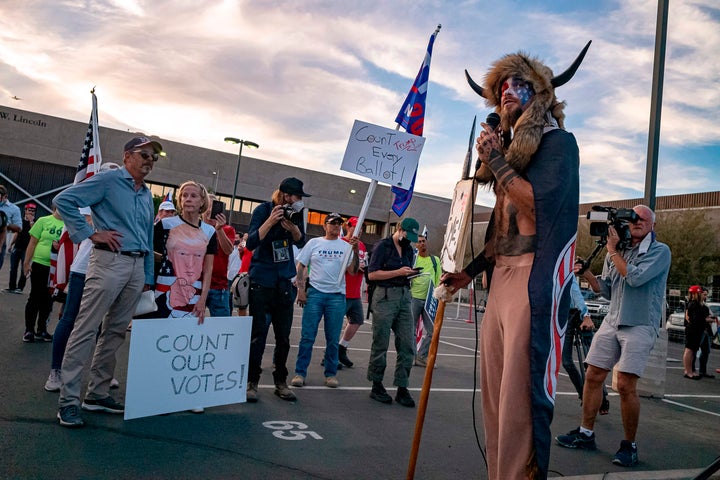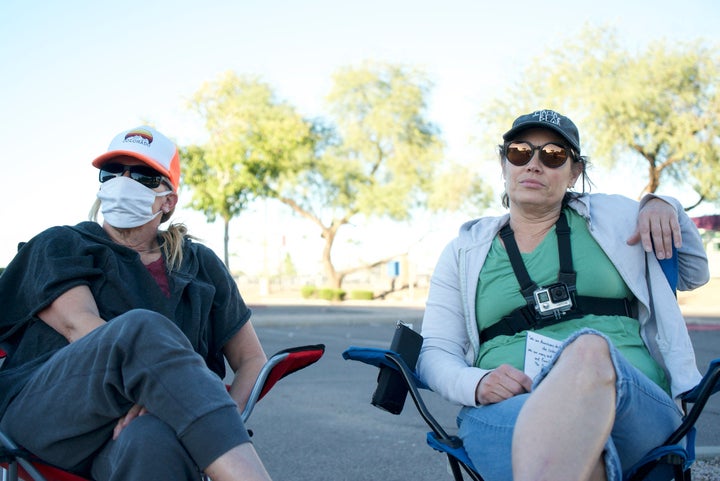Two-and-a-half hours after polls closed in every state in the 2020 election, then-President Donald Trump declared victory and said he was going to ask the U.S. Supreme Court to stop states from counting any more legally cast ballots.
“We want all voting to stop. We don’t want them to find any ballots at four in the morning and add them to the list,” Trump said before adding, “Frankly, we did win the election.”
As the hours turned into days before the presidential election was finally called for Democrat Joe Biden, Trump built his lie that the election was stolen from him. The late-counted, or “overtime,” ballots (generally mail ballots and provisional ballots) cast in heavily Black and Latino counties favoring Democrats were deemed fraudulent. Election workers had switched real votes for fake ones, whether by USB drive or ballot drop boxes, Trump and his allies claimed. And on and on. The claims referred to the presidential votes only, though, while Republican victories from the same ballots were accepted.
Of course Trump was going to contest the results — at the time he was still disputing the outcome of an election he’d won. He repeatedly claimed he actually won the popular vote in 2016 “if you deduct the millions of people who voted illegally.” In 2018, he lied that Democrats were involved in a “big corruption scandal having to do with Election Fraud,” when ballots counted after Election Day favored Sen. Bill Nelson (D-Fla.), who ultimately lost. He also falsely declared “electoral corruption” and called for a “new Election” when Sen. Kyrsten Sinema (D-Ariz.) defeated incumbent Republican Martha McSally after ballots counted after Election Day came in.
In each case, Trump’s lies revolved around the mechanics of election administration: how voters cast their ballots and how states counted them. The counting of ballots after Election Day turned into evidence of fraud in his imagination. And though none of his claims were true and all were fact-checked by the press and election law experts and readily dismissed from the courts, the Republican Party grasped onto them and won’t let go.
This presents the possibility of yet another nightmare following Election Day on Nov. 8. Little has changed in how the votes will be cast and how they will be counted in key states across the country. The same scenario that Trump used to lie about the election results in the past three elections will happen again. The only difference is that this year there are hundreds of Republicans who endorse his lies running for offices up and down the ballot.
Refusal To Accept Defeat

Since Trump left office, Republicans have been seeding the idea that all elections they do not win would have been necessarily corrupted by fraud.
“I’m going to win the election, and I will accept that result,” Arizona Republican gubernatorial candidate Kari Lake, who claims to not believe Biden won the 2020 election, said Oct. 16 on CNN while pointedly refusing to state whether she would accept the results if she lost.
“We’ve an absolute right to have it proven to us that the election was fair. If it is fair, Kari Lake’s going to win,” Fox News host Tucker Carlson said on Oct. 20.
Carlson, the most influential conservative television news host, told his viewers on Oct. 26 that it would be “absurd” to “accept the outcome” of the Pennsylvania Senate race if Lt. Gov. John Fetterman, the Democratic nominee, wins.
In Michigan, GOP gubernatorial candidate Tudor Dixon, who also claims the 2020 election was stolen from Trump, said during a primary debate that she will accept the results only if “we see the secretary of state running a fair election the way she should be.”
At a campaign stop in October, Arizona GOP Senate candidate Blake Masters continued to spread lies that the voting machines in the state are corrupted and that if he beats Sen. Mark Kelly (D-Ariz.) by 30,000 votes, Democrats may just “find 40,000,” according to The Daily Beast. “There’s always cheating, probably, in every election,” Masters told supporters in July. (When speaking to a mass audience during a televised debate on Oct. 6, however, Masters admitted, “I haven’t seen evidence of” election or voter fraud in the 2020 presidential election.)
Don Bolduc, the Republican Senate candidate in New Hampshire, has repeatedly stated that there was widespread fraud in the 2020 election and refused to say if he will accept his own election results. Bolduc warned during an appearance on a conservative radio show on Oct. 10 that if the vote count were close on Election Day, ballots favoring Democrats could be reported overnight, “and the next thing you know, you wake up in the morning and the election is changed. That is still real.”
In Wisconsin, Republican Sen. Ron Johnson and GOP gubernatorial candidate Tim Michels refuse to say that they would accept the outcome of their elections.
GOP secretary of state candidates in Arizona, Michigan, Minnesota and Nevada all believe that the 2020 election was illegitimate and refuse to accept the 2022 results ― if they lose, of course.
Doug Mastriano, the far-right election-denying GOP gubernatorial candidate in Pennsylvania, led Trump’s efforts to overturn the presidential election results in the state and has refused to say whether he would accept the results of his own election.
These repeated claims, from GOP politicians and the movement’s media superstars, have conditioned the base to believe in widespread voter fraud; a recent poll showed two-thirds of Republican voters do not accept that Biden fairly won the 2020 election. So when there’s another delayed count in the upcoming midterms, all hell may break loose once again.
Blue Shift ’22

The dynamic that the GOP election lies rest on is known as the “blue shift.” First named in a 2013 political science paper, the blue shift describes how late-counted ballots tend to favor Democratic Party candidates due to Democratic voters’ higher propensity to cast late absentee ballots, use provisional ballots and their need to “cure,” or correct, errors on absentee ballots.
The blue shift appeared to accelerate in 2020 when Republicans abandoned mail-in voting amid Trump’s propaganda campaign against it while Democrats embraced it. But as a post-election report by the MIT Election Data + Science Lab shows, both late-counted ballots and the blue shift two years ago were “comparable in size to the 2016 election.”
Not only was the blue shift comparable to the 2016 election, but most states reported vote totals quickly with only 10 states and the District of Columbia not reporting 90% or more of their final vote 48 hours after the polls closed.
“In almost every state, the presidential victor was clear within five hours of polls closing,” the report states. “In the few exceptions, the problem was not wild gyrations in reported election results, but the simple fact that the vote count was close.”
What mattered, ultimately, was that the vote totals were close enough in states like Arizona, Georgia, Michigan, Nevada, Pennsylvania and Wisconsin to delay major outlets from calling the results ― and thus the final outcome of the presidential race. And then Trump was eager to lie about election fraud.
The Republican Party’s current embrace of Trump’s lies are paramount here. It plans to claim election fraud even if the party wins, just as Trump did in 2016.
Election protection workers point to Arizona, Michigan, Nevada, Pennsylvania and Wisconsin as the key states where they are concerned about false claims of fraud post-election. These are among the same states that featured closely fought races and took longer to report over 90% of their vote totals — and now feature GOP candidates running who will refuse to accept the results if they lose. This promises to create a chaotic situation after the polls close.
In Michigan, Pennsylvania and Wisconsin, the high rate of late-counted ballots can be chalked up to both the refusal of Republicans in state legislatures to pass bills allowing mail ballots to be processed prior to Election Day and the fact that votes were counted at centralized locations in the counties, requiring the ballots to be transported.

Mailed ballots need to be processed before they are counted. Ballot processing can involve opening the envelopes, removing the ballots from their envelopes and doing a signature match or entering the ballots into a tabulation machine. By allowing already returned ballots to be pre-processed, states can ease the burden placed on election workers on and after Election Day.
In the last election, Michigan and Pennsylvania saw their largest counties, which contain the largest share of Democratic voters, take much longer to report their ballots. Eight hours after the polls closed, only 47% of the vote was reported in Wayne County, Michigan, and 53% for Philadelphia County, Pennsylvania. The vote total for Pennsylvania didn’t hit 90% of the final vote until more than 24 hours after the polls closed. This could have been caused by the centralization of vote counting at the county level, rather than the municipal, according to the MIT Election Data + Science Lab report.
To alleviate at least some of this burden, Michigan adopted legislation allowing counties to process mail ballots up to two days prior to Election Day. But election clerks noted that this change came too close to the election to enable their offices to properly speed up the counting of ballots. It is most likely that the full results will not be complete until 24 hours after polls close.
This may relieve some of the crush, but those ballots would still need to be counted on Election Day while any mail ballots returned on Election Day would still need to be processed and then counted.
Republicans in Wisconsin and Pennsylvania continued to refuse to allow any time for ballots to be pre-processed after 2020.
“We were saying, in Pennsylvania you have to pass something to deal with pre-processing,” said Sylvia Albert, director of voting and elections for Common Cause, a nonprofit active in monitoring elections. “To me, at this point, it is purposeful. They want chaos. If you refuse to pass laws, you are asking for what’s next.”
This will likely matter greatly in Pennsylvania if the Senate or gubernatorial races are close, as they are projected to be, since Democrats continue to request mail ballots at a far higher rate than do Republicans. Trump is reportedly looking to contest election results in Pennsylvania, according to Rolling Stone.
So far, Democrats account for 70% of requested mail ballots and 72% of returned mail ballots. The total could account for about one-quarter of the vote total for Democratic candidates if turnout winds up somewhere in between the 2018 midterms and the 2020 presidential election.
“We know everyone [will] want results on election night, but we must again ask for patience,” acting Pennsylvania Secretary of the Commonwealth Leigh Chapman told reporters on Oct. 11.
“We were saying, in Pennsylvania you have to pass something to deal with pre-processing. To me, at this point, it is purposeful. They want chaos. If you refuse to pass laws, you are asking for what’s next.”
- Sylvia Albert, Common Cause
Arizona, where every Republican running statewide claims the 2020 election was riddled with fraud, was among the 10 states that did not report more than 90% of their total vote within 48 hours of the polls closing. Recent statewide elections in the state have been incredibly close. Biden defeated Trump by a little more than 10,000 votes. Kelly won his 2020 race by around 70,000 votes, and Sinema won her 2018 race by less than 60,000.
The state has since become a hotbed of election-related conspiracy theories, with the state legislature voting to audit the vote in Maricopa County, which holds 60% of the state’s population, after Biden won it in 2020. The partisan audit was highly contentious but ended by showing that there was no widespread fraud in the election. (Biden actually gained votes in the audit’s final tally.)
Most Arizona voters cast their ballots by mail, and the state does allow election workers to pre-process and count those ballots ahead of Election Day. But a large number of voters return their ballots on Election Day. The “late early votes,” as they’re called in the state, make Arizona one of the states with the largest overtime vote count. Arizona also allows voters to correct any errors on their ballot up to five days after the election.
“If elections are close, it might be a week or more before we have solid results,” said Alex Gulotta, Arizona state director for All Voting Is Local, a nonprofit voting rights and election protection group. “And that’s in the normal course.”
Like Arizona, Nevada did not report more than 90% of its vote until over 48 hours after polls closed. The high overtime vote in the state is likely chalked up to its rules around mail voting. All voters are provided a mail ballot, which can be accepted up to four days after the election if it is postmarked on or before Election Day. Voters are also given up to seven days after the election to cure any errors found on their ballots. Nevada has a tight Senate race between incumbent Sen. Catherine Cortez Masto (D) and GOP challenger Adam Laxalt, who has refused to answer multiple questions from local media about whether he will accept the midterm election result but did tell The New York Times and The Washington Post that he would accept the results.
While the 2020 overtime vote in Arizona actually provided a “red shift,” in which Trump gained votes in the days after the election, the state saw a blue shift in 2018 that put Sinema in the lead in her race. In Nevada, the overtime vote first tilted to Republicans as rural counties were reported before tilting back toward Democrats as more ballots were counted in Clark County, which includes Las Vegas.
Post-Election Chaos

The lies Republicans spread about the post-election vote count highlight a mostly overlooked aspect of elections: that they do not end on Election Day. Ballots must be processed, counted, canvassed and certified. When elections are extremely close, recounts may be in order depending on each state’s recount laws.
“In the past, election protection broadly has been about focusing on how we are preparing up to the election ― the day before and the day of the election,” said Quentin Turner, director of Common Cause Michigan. “But in the past couple years, that has changed. The days leading up to and on Election Day are the pregame. The work continues on in just as an intense way after the election. And that is where the most opportunities are for people who want to sow discord or doubt in the process.”
Just as Trump put pressure on each hinge point in how the Electoral College votes are cast, so too can Republicans who reject the outcome of their elections this year apply pressure in their states.
That pressure has already been applied to election workers across the country as they have received a steady stream of death threats from Trump-backing election deniers since the 2020 election. Numerous election workers have already been driven out of office by election-denying conspiracists hounding their every move. Trump-backing militias like the Oath Keepers and other groups have also staked out drop boxes in Arizona, intimidating voters as they deliver their mail-in ballots.
These kinds of intimidation campaigns could go into a higher gear after the election. If a race is close, pressure could be applied to officials counting or certifying votes to change the outcome. And just as the outcome on Jan. 6, 2021, hinged on Vice President Mike Pence not following Trump’s orders, all of the processes that provide an opportunity for mischief rely on the officials overseeing them to act in good faith.
In Michigan, Turner said that the most worrying period is the 14 days after the election, when county totals are canvassed and certified by local boards of canvassers. In 2020, two Republican members of the Wayne County board of canvassers initially attempted to vote against certifying the totals from the largest county in the state after being pressured by Trump and his supporters.
Though those two members reversed themselves and certified the legitimate vote totals, the newest Republican member of the board, appointed in 2021, said he would not have certified the 2020 election. Election deniers were appointed to county boards of canvassers in at least two other Michigan counties ahead of the 2022 election.
“We don’t know how the boards of canvassers are going to end up voting,” Turner said. “Hopefully, they all do their jobs like they’re supposed to.”

The refusal of GOP election officials to certify results is not far-fetched. These officials refused to certify election results in 10 counties in Nevada, New Mexico and Pennsylvania during the 2022 primary elections. In a few of these cases, the county election boards needed to be taken to court to be forced to certify the election results. It took three months of litigation before the Pennsylvania counties of Berks, Butler, Fayette and Lancaster complied and certified all votes cast.
In rural Nye County, Nevada, the election-denying head of elections, Mark Kampf, is forcing the county to hand-count ballots, due to the conspiratorial fears of voting machines whipped up by Trump in 2020. The county is already counting early votes, showcasing how hand-counting is a time-consuming and error-prone process. The Nevada secretary of state told Nye County to cease its hand count on Thursday.
Elections officials of Cochise County, Arizona, also tried to count their ballots only by hand, but they agreed to abide by a court order telling them to stop on Thursday.
“It is fairly likely that some election administrator somewhere in the country is probably going to refuse to certify the results in their jurisdiction for some reason,” said Adav Noti, legal director of the nonprofit Campaign Legal Center, which is engaged in election protection efforts.
The final certification of the vote in Arizona could stretch out even further after Republicans increased the threshold for recounts in close elections. Previously, a recount would be triggered if the election margin was within 0.1%. But now a recount will occur when elections are within 0.5%. This difference would have required a recount for Biden’s win over Trump in 2020 as well as numerous other state and local races up and down the ballot.
This change would extend the amount of time when the final outcome of a close race would be either unclear or open to debate possibly into December. This could potentially give one of the many election-denying Arizona candidates extra time to whip up paranoia about the election results and put increased pressure on election workers.
“That is a difference from 2020 that is very dangerous,” Gulotta said.
The counting of these ballots on Election Day and after will be closely observed by poll watchers recruited by the Republican National Committee and former Trump adviser Steve Bannon. Poll watchers may object to votes, gum up the election process and spread lies about the conduct of the election, just as they did in 2020. John Eastman, the conservative lawyer who drafted Trump’s plan to steal the 2020 election on Jan. 6, 2021, exhorted GOP poll workers and observers in New Mexico to challenge individual votes as part of a scheme to challenge the results of elections Republicans lose, according to Politico.
Election protection groups and legal allies are anticipating a flood of activity on and after Election Day. And with many key races neck-and-neck in the polls, another post-election frenzy of litigation is expected. Republicans may very well be as unsuccessful as they were in the courts and the streets in 2020.
But the rot in American elections appears to be setting in. Trump’s lies have taken hold of the Republican Party. Every election now features figures who do not believe in the function of democratic elections, unless they win them.
And if they do win in 2022, then they will be in a position to ensure Trump has the crucial allies he lacked in 2020 when he called for “all voting to stop.”

